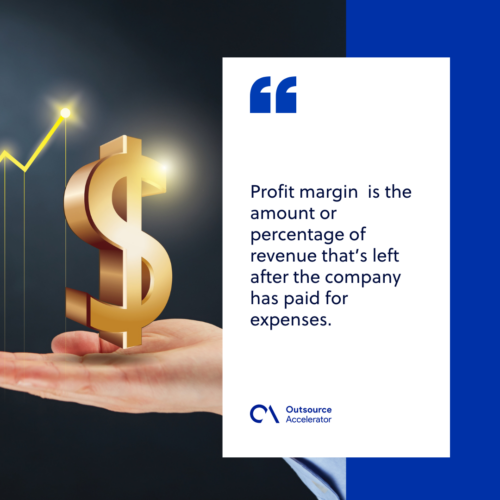Profit margin
Definition
What is profit margin?
Profit margin is an accounting term that measures the profitability of a company or a product. It is the amount or percentage of revenue that’s left after the company has paid for expenses. It estimates how much of a company’s sales have resulted in a profit.
While growing financial profit is excellent, it has little meaning unless tied to its source. That’s why corporations analyze profit margin and profit rate. Profit margin compares earnings to costs or sales for a given period.
There are various factors that affect the profit margin. A low profit margin does not necessarily mean that a business is performing poorly, as is the case with industries such as real estate and automobiles.
However, it’s safe to say that businesses should generally aim for a high profit margin.

Basic types of profit margin
The following section explains the features and formulas of each profit margin type.
Operating profit margin
The operating cost includes all overhead, operating, administrative, and sales expenditures. Overhead expenditures, as well as costs of goods sold, are included in the calculation of operating profit margin. No non-operating expenses like loans or taxes are included.
Gross profit margin
An organization’s gross profit margin can be calculated by deducting the cost of goods sold (COGS) from the net sales, the result of which is divided by the net revenues and multiplied by 100%.
Net profit margin
This type of profit margin is perhaps the most crucial for most companies. The net profit margin is obtained by dividing the net income by the net sales. It takes into account all expenses such as operating and overhead costs.
Advantages of setting a profit margin
Listed below are some advantages of checking a company’s profit margin:
- Using profit margin directly compares profit and cost at every sales level. Any cost reduction increases profit margin.
- It improves measuring a company’s financial health and allows for peer comparison.
- Organizations must find new ways to quantify pricing changes that impact profitability without profit margins.
- It shows a company’s cost efficiency and helps track its performance over time.
Disadvantages of setting a profit margin
Here are some disadvantages of profit margin:
- It is vulnerable to manipulation.
- Although cost and profit are closely associated in calculating profit margin, profit margin alone does not reveal the actual cost efficiency in generating sales.
- Without total sales volume, profit margin alone cannot reveal a company’s entire profit level. Companies with solid profit margins but limited sales volume may have low profits. Price increases rather than cost reductions may cause a decline in sales volume.
- If used to compare companies across industries or sectors, the profit margin may be useless.







 Independent
Independent




